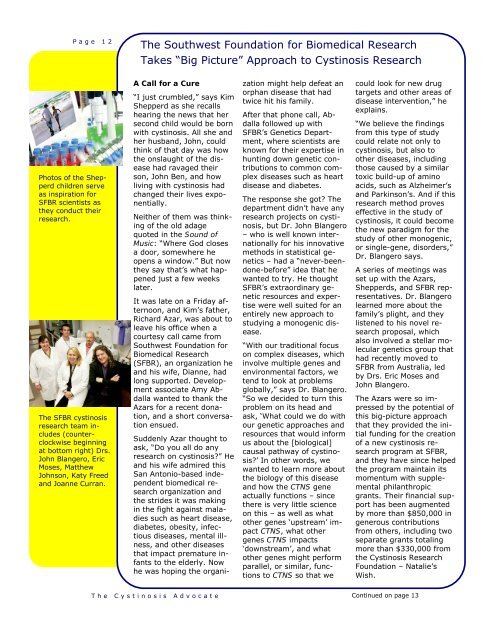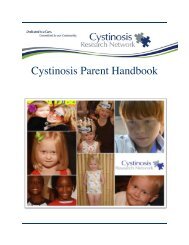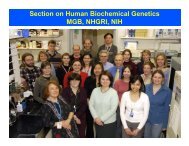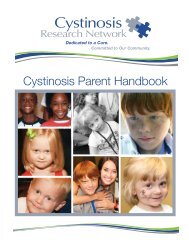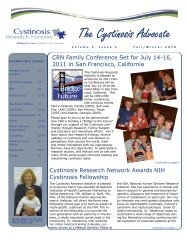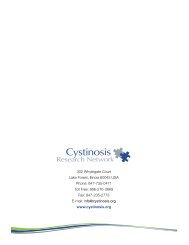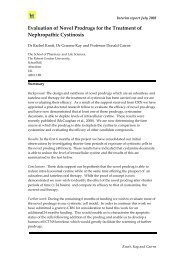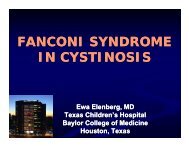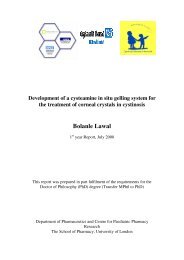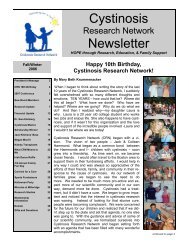Spring/Summer - Cystinosis Research Network
Spring/Summer - Cystinosis Research Network
Spring/Summer - Cystinosis Research Network
Create successful ePaper yourself
Turn your PDF publications into a flip-book with our unique Google optimized e-Paper software.
Page 12<br />
The Southwest Foundation for Biomedical <strong>Research</strong><br />
Takes “Big Picture” Approach to <strong>Cystinosis</strong> <strong>Research</strong><br />
Photos of the Shepperd<br />
children serve<br />
as inspiration for<br />
SFBR scientists as<br />
they conduct their<br />
research.<br />
The SFBR cystinosis<br />
research team includes<br />
(counterclockwise<br />
beginning<br />
at bottom right) Drs.<br />
John Blangero, Eric<br />
Moses, Matthew<br />
Johnson, Katy Freed<br />
and Joanne Curran.<br />
A Call for a Cure<br />
“I just crumbled,” says Kim<br />
Shepperd as she recalls<br />
hearing the news that her<br />
second child would be born<br />
with cystinosis. All she and<br />
her husband, John, could<br />
think of that day was how<br />
the onslaught of the disease<br />
had ravaged their<br />
son, John Ben, and how<br />
living with cystinosis had<br />
changed their lives exponentially.<br />
Neither of them was thinking<br />
of the old adage<br />
quoted in the Sound of<br />
Music: “Where God closes<br />
a door, somewhere he<br />
opens a window.” But now<br />
they say that’s what happened<br />
just a few weeks<br />
later.<br />
It was late on a Friday afternoon,<br />
and Kim’s father,<br />
Richard Azar, was about to<br />
leave his office when a<br />
courtesy call came from<br />
Southwest Foundation for<br />
Biomedical <strong>Research</strong><br />
(SFBR), an organization he<br />
and his wife, Dianne, had<br />
long supported. Development<br />
associate Amy Abdalla<br />
wanted to thank the<br />
Azars for a recent donation,<br />
and a short conversation<br />
ensued.<br />
Suddenly Azar thought to<br />
ask, “Do you all do any<br />
research on cystinosis” He<br />
and his wife admired this<br />
San Antonio-based independent<br />
biomedical research<br />
organization and<br />
the strides it was making<br />
in the fight against maladies<br />
such as heart disease,<br />
diabetes, obesity, infectious<br />
diseases, mental illness,<br />
and other diseases<br />
that impact premature infants<br />
to the elderly. Now<br />
he was hoping the organi-<br />
zation might help defeat an<br />
orphan disease that had<br />
twice hit his family.<br />
After that phone call, Abdalla<br />
followed up with<br />
SFBR’s Genetics Department,<br />
where scientists are<br />
known for their expertise in<br />
hunting down genetic contributions<br />
to common complex<br />
diseases such as heart<br />
disease and diabetes.<br />
The response she got The<br />
department didn’t have any<br />
research projects on cystinosis,<br />
but Dr. John Blangero<br />
– who is well known internationally<br />
for his innovative<br />
methods in statistical genetics<br />
– had a “never-beendone-before”<br />
idea that he<br />
wanted to try. He thought<br />
SFBR’s extraordinary genetic<br />
resources and expertise<br />
were well suited for an<br />
entirely new approach to<br />
studying a monogenic disease.<br />
“With our traditional focus<br />
on complex diseases, which<br />
involve multiple genes and<br />
environmental factors, we<br />
tend to look at problems<br />
globally,” says Dr. Blangero.<br />
“So we decided to turn this<br />
problem on its head and<br />
ask, ‘What could we do with<br />
our genetic approaches and<br />
resources that would inform<br />
us about the [biological]<br />
causal pathway of cystinosis’<br />
In other words, we<br />
wanted to learn more about<br />
the biology of this disease<br />
and how the CTNS gene<br />
actually functions – since<br />
there is very little science<br />
on this – as well as what<br />
other genes ‘upstream’ impact<br />
CTNS, what other<br />
genes CTNS impacts<br />
‘downstream’, and what<br />
other genes might perform<br />
parallel, or similar, functions<br />
to CTNS so that we<br />
could look for new drug<br />
targets and other areas of<br />
disease intervention,” he<br />
explains.<br />
“We believe the findings<br />
from this type of study<br />
could relate not only to<br />
cystinosis, but also to<br />
other diseases, including<br />
those caused by a similar<br />
toxic build-up of amino<br />
acids, such as Alzheimer’s<br />
and Parkinson’s. And if this<br />
research method proves<br />
effective in the study of<br />
cystinosis, it could become<br />
the new paradigm for the<br />
study of other monogenic,<br />
or single-gene, disorders,”<br />
Dr. Blangero says.<br />
A series of meetings was<br />
set up with the Azars,<br />
Shepperds, and SFBR representatives.<br />
Dr. Blangero<br />
learned more about the<br />
family’s plight, and they<br />
listened to his novel research<br />
proposal, which<br />
also involved a stellar molecular<br />
genetics group that<br />
had recently moved to<br />
SFBR from Australia, led<br />
by Drs. Eric Moses and<br />
John Blangero.<br />
The Azars were so impressed<br />
by the potential of<br />
this big-picture approach<br />
that they provided the initial<br />
funding for the creation<br />
of a new cystinosis research<br />
program at SFBR,<br />
and they have since helped<br />
the program maintain its<br />
momentum with supplemental<br />
philanthropic<br />
grants. Their financial support<br />
has been augmented<br />
by more than $850,000 in<br />
generous contributions<br />
from others, including two<br />
separate grants totaling<br />
more than $330,000 from<br />
the <strong>Cystinosis</strong> <strong>Research</strong><br />
Foundation – Natalie’s<br />
Wish.<br />
The <strong>Cystinosis</strong> Advocate<br />
Continued on page 13


